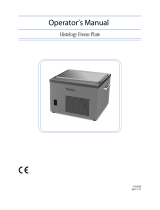
How to use your new Bare-Handed Microtome
(United Sc. Item No. MCT001)
Introduction:
The Bare-Handed Microtome is designed for use in introductory biology and histology
work. It is capable of slicing micro thin sections as thin as 0.01mm (10 microns). It
consists of a piston screwed into a tube whose free end is fixed into a flat plate serving as
a stage. The knurled base at the bottom of the instrument moves the piston up or down
the central tube when rotated. The specimen is fixed on the flat top of the piston and
sections are cut by drawing a razor over the upper flat surface of the instrument. The
piston has a clamping mechanism for securing objects of different shapes and sizes. The
instrument is graduated in 10-micron (0.01mm) increments. If a sample is initially cut at
the zero graduated mark, rotating the base from 0 to 1 will raise the piston 100 micron
(0.10mm). Taking a slice at this position will produce a 100 micron (0.10mm) section. It
follows that each complete turn of the base will produce a 500 micron (0.50mm section).
Directions:
1. Open the wooden case and place the microtome on a flat surface with the knurled base
end down.
2. Select the sample to be sectioned.
3. Trim the sample to fit into the piston hole at the top of the microtome. Firm samples
such as a carrot, onion etc. can be inserted and secured in the piston without embedding
in paraffin. A thin fragile specimen, such as a small plant root tip, may need to be
embedded in paraffin before insertion.
3. Open the sample clamp as wide as it can go by turning the round sample knob. The
sample knob is the small knurled knob protruding horizontally from the middle (stem) of
the instrument. Place your sample in the piston hole at the top of the microtome. Adjust
the sample knob to secure your sample.
4. Place the round glass disk on the flat stage on the top of the microtome.
5. Adjust the sample so that it protrudes above the glass surface. This can be
accomplished by rotating the knurled base and/or loosening the sample clamp and
moving the sample up or down in the piston.
6. Turn the knurled base so that the “0” is aligned with the reference line on the stem of
the instrument.
7. Glide the blade on the razor parallel with the glass surface. Slice the sample so it is
exactly even with the surface of the glass.
8. Turn the knurled base counterclockwise to achieve the desired section thickness.
/

